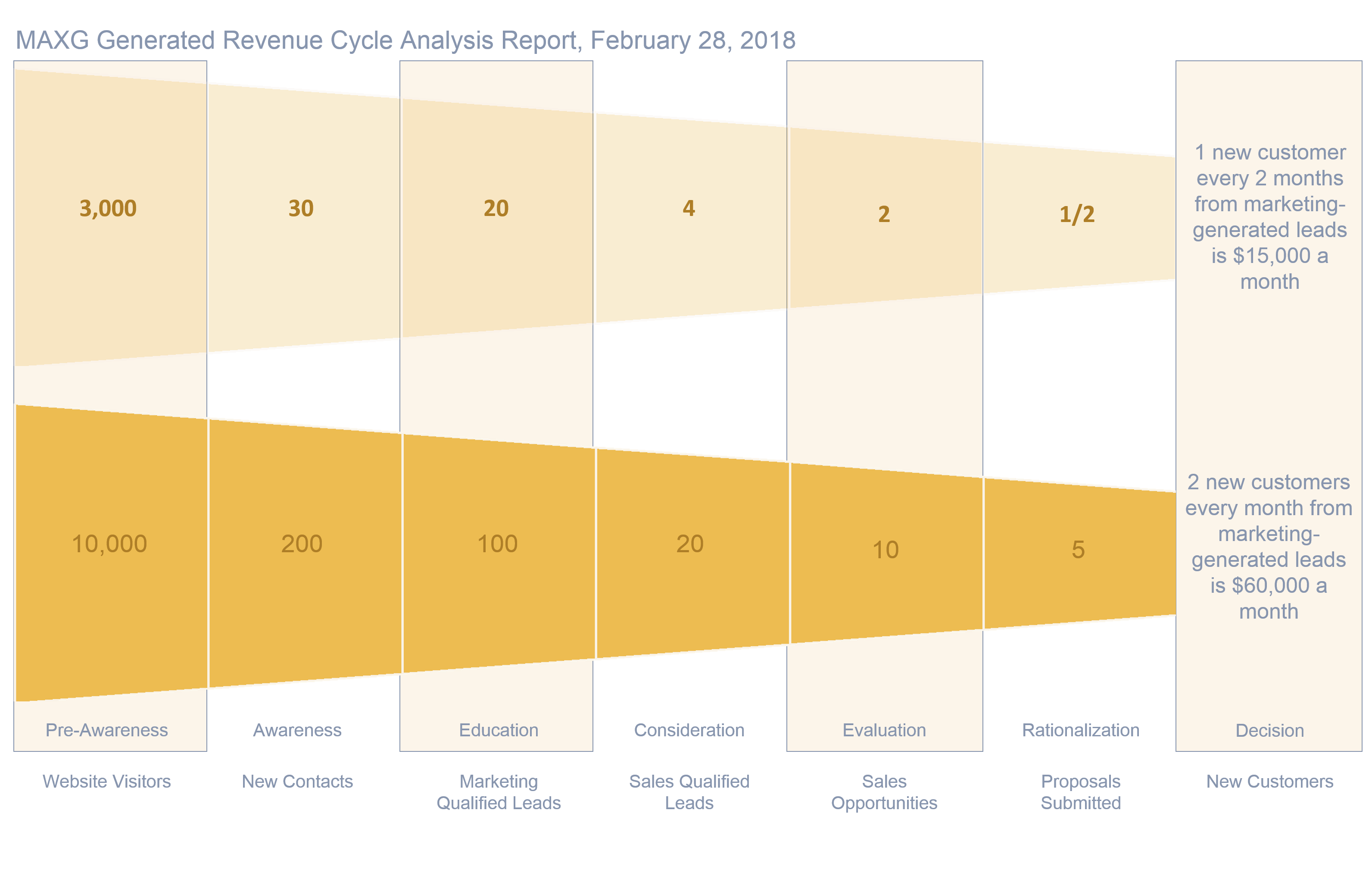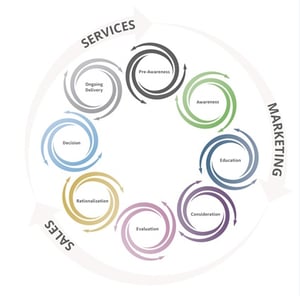
Why We Don’t Use The F-Word At Square 2 Marketing Anymore
The Traditional Sales Funnel Is Over 100 Years Old, And It’s Time For Retirement
 No, I’m not talking about the curse word that starts with “F.” I’m talking about “funnel,” and we’re no longer using the word funnel internally or externally with clients because it doesn’t illustrate anything close to the process your prospects are going through when making a purchase decision.
No, I’m not talking about the curse word that starts with “F.” I’m talking about “funnel,” and we’re no longer using the word funnel internally or externally with clients because it doesn’t illustrate anything close to the process your prospects are going through when making a purchase decision.
I also believe that continuing to think of the buyer journey as three simple stages, with gravity contributing to pulling people through, is a major contributor to the challenges people are having with their marketing and sales execution, as well as setting expectations around results.
Since we’re not talking about the f***** anymore, then what are we talking about?
The Revenue Cycle
When salespeople controlled the entire process, the idea of a f***** made sense. But today, buyers are in control. Instead of the f*****, we like to think of the process as a revenue cycle.
This cycle is the process of securing new revenue. The faster the cycle, the faster the inflow of revenue. And the cycle does not only focus on new customers. It focuses on anywhere revenue exists, including with current customers.
There is still a beginning, middle and end to the buyer journey. Yes, the journey continues when prospects become customers, so the idea of a continuing cycle is very relevant.
That’s something the traditional sales f***** does not address. We use the revenue cycle concept to create the metrics associated with the cycle. The metrics might resemble the old f***** model, but it has more granularity to it because we need a more detailed look at the performance of the revenue cycle to know how and when to deploy certain tactics.

You’ll also notice it runs horizontally, not vertically. It’s a reminder that we have to be an active participant in moving prospects through their buyer journey, and the better you are at this, the faster the revenue cycle moves.
It’s the combination of this metrics-focused cycle and the new eight-stage Cyclonic Buyer Journey™ that helps us proactively manage the application of strategy, tactics, metrics and technology across marketing, sales and customer service to produce results and business outcomes for our clients.
An Eight-Stage Buyer Journey
 When we first started working with clients back in 2003, a real misunderstanding existed around how to apply tactics (and specifically content) to the different stages of the buyer journey.
When we first started working with clients back in 2003, a real misunderstanding existed around how to apply tactics (and specifically content) to the different stages of the buyer journey.
When there were only three stages (awareness, consideration and decision), we created content offers for each stage.
No-risk offers were for people looking around (awareness), low-risk offers were for people willing to get a little closer to your company (consideration) and direct business offers were for people who wanted to talk to you (decision).
In most cases, people we met had the first part down, and most of their content was for the top of the f*****. But the rest was pretty bad.
They might have had a webinar offer for a middle-of-the-f***** offer, and in most cases they whiffed completely on the bottom-of-the-f***** offer, giving prospects the basic “contact us,” “speak with a rep” or “request a demo.”
There was little or no creativity or understanding of value being deployed into their strategy, especially in the middle and back end of the buyer journey. To better understand today’s buyer journey and to help our clients build a more remarkable buyer journey experience, you have to dig a little deeper and understand all eight stages.
This understanding (from the buyer/prospect’s perspective) allows you to deliver content in context, align marketing with sales and integrate new tools like chat or video. It also allows you to track both tactic-specific metrics, like click-through rate on content-related landing pages, while also tracking higher-level metrics, like conversion rates from stage to stage and improvements on the overall time it takes to close a new customer.
You just can’t drive improvement without both perspectives.
A Better Alignment Of Sales, Marketing And Customer Service
The old sales f***** never did marketing or sales any favors when it came to getting these two historically feuding factions together. Sales felt like they owned the entire process (and they did up to a few years ago), and marketing wanted a lot more control of the process.
In our new eight-stage Cyclonic Buyer Journey model, it’s pretty clear where the handoff is these days (the Evaluation Stage), but it’s also clear when you start mapping tactics to this new buyer journey model that you have sales involvement (or you should have sales involvement) in almost every stage.
This illustrates what marketers have been trying to tell sales teams for years: Prospects don’t view their experience as marketing or sales. They view it as one single seamless experience with a single company.
They want their experience to be amazing regardless of who they talk to and when. Once you start looking at the overall experience, mapping tactics, tracking different metrics and using software, you quickly get to realize that revenue is locked up in the customer base.
Almost equally interesting is you also realize you need the customer base to be part of the sales and marketing exercise because the buyer journey has changed.
You need them to advocate for your business. You need their reviews, references, case studies, success stories and participation in both sales and marketing if you want to drive your revenue cycle to spin faster.
In addition, applying marketing to the experience customers have with the services team can drive a lot of incremental revenue.
Giving them better email templates and better scripts, and providing them content that helps customers make smarter decisions, is going to produce a better experience, more cross-sell opportunities, more upsell opportunities and an increased retention rate — all revenue-generating activities.
Surveys, net promotor scores and other feedback loops should be built and deployed to introduce metrics into the customer service and delivery stage of the buyer journey.
Marketing can have a major impact on the revenue from current customers with even a little energy focused in this area.
Want to improve revenue generation at your company? Want to install a revenue generation machine at your business? Then you’ll need to start thinking differently about marketing, sales and customer service.

CEO and Chief Revenue Scientist
Mike Lieberman, CEO and Chief Revenue Scientist
Eliminate Hit-or-Miss Marketing Moves
Get advice, tips, tools and guidance to generate more leads for your company in this weekly email newsletter.



Eliminate Hit-or-Miss Marketing Moves
Get advice, tips, tools and guidance to generate more leads for your company in this weekly email newsletter.













